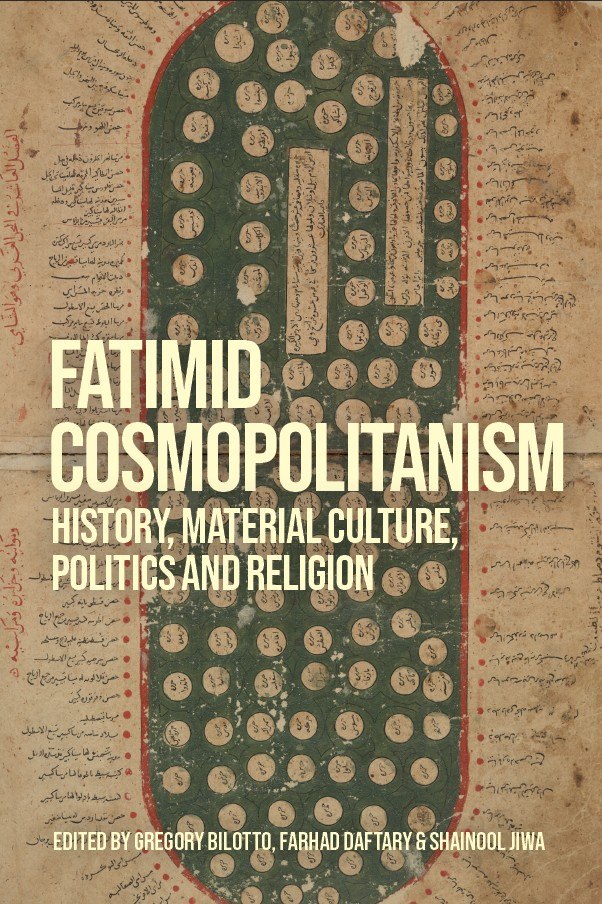This book is also available OPEN ACCESS to download or read online for free.
The Fatimid caliphs (297–567/909–1171), who were also the Ismaili Imams, reigned over a vast state stretching from North Africa (including Egypt) to Sicily, Syria and the Hijaz(Arabic; lit. ‘the barrier’). A region in the west of present-day Saudi Arabia along the Red Sea which includes some of the holiest sites and cities for all Muslims —…. Under Fatimid patronage, the arts and sciences flourished alongside Ismaili thought and literature. An extensive trade network was centred on their capital, Cairo, facilitating cosmopolitan exchange across their caliphateThe Muslim political institution or state centred around the caliph, which came to an end, historically, in 1924 with the disappearance of the Ottoman Empire., the Mediterranean and other lands. This led to innovation in the production of decorative arts, monumental building programmes, international commerce and significant intellectual exchange.
The original research of 22 scholars is here organised into four sections on aspects of Fatimid cosmopolitanism, covering religion and statecraft, the Fatimid legacy reconsidered, ceremony and symbolism and art and archaeology.
List of Contributors
Preface by Gregory Bilotto
List of Abbreviations
Section I. Fatimid Religion and Statecraft
-
Ismaili Neoplatonism: The Cosmopolitan Legacy of the Fatimid Ismaili Daʿwa
Khalil Andani -
Who was Nasir-i Khusraw’s Patron in Yumgan? Notes on the Political Vectors of the Late Fatimid Daʿwa
Daniel Beben -
The Reign of the Fatimid Imam-caliph al-Hakim bi-Amr Allah: Historiographical Considerations
Shainool Jiwa -
The Fatimid Kitab al-Majalis wa’l-musayarat as Responsa to Internal Controversy and External Propaganda
Hasan al-Khoee -
(Re)-making time, (Re)-making place: Some Considerations on Early Fatimid Taʾwil and Sacred Space
Jamel A. Velji -
Fatimid Public Pronouncements: Messages from a Shiʿi Dynasty to a Cosmopolitan Empire
Paul E. Walker
Section II. The Fatimid Legacy Reconsidered
-
The Modern Rediscovery of the Fatimid Artistic and Architectural Legacy in Egypt
Dina Ishak Bakhoum -
A Dynasty for All Seasons: The FatimidsMajor Muslim dynasty of Ismaili caliphs in North Africa (from 909) and later in Egypt (973–1171) More in Modern and Contemporary Cosmopolitanism Discourses
Delia Cortese -
Wladimir Ivanow and Fatimid Studies
Farhad Daftary -
The Untold Problem of Ibn al-Haytham’s Scientific Legacy in Islamic Art History
Valérie Gonzalez -
The Fatimids and the Indian Ocean: Evidence from the Book of Curiosities
Yossef Rapoport
Section III. Fatimid Ceremony and Symbolism
-
The Fatimid Crescent: Understanding a Complex Religio-Political Cosmos through Lunar Symbolism
Ali Asgar Hussamuddin Alibhai -
The Power of Six: Astral, Solomonic and Imami Imagery in Fatimid Art
Bernard O’Kane -
The Cosmopolitan Ecosystem of the Festival Costumes of 515/1122
Paula Sanders -
Back to Black Background: The Rediscovery of Black Background and the Aesthetic of Darkness – A Global Visual Spectacle during the Fatimid Age
Avinoam Shalem -
Displaying the Hidden: Fatimid Public Texts in Floriated Kufic
Yasser Tabbaa
Section IV. Art and Archaeology
-
A Fatimid Mermaid
Doris Behrens-Abouseif and Juan de Lara -
‘The Work is Blessed, Unique’: The Fatimid Silver Casket of Sadaqa b. Yusuf
Anna Contadini -
Fatimid Jewellery Hoards from Palestine in the Light of the Cairo Geniza Documents
Ayala Lester -
The Fatimid Rock Crystal Ewers: Innovation or Variation? A Historical and Iconographical Investigation
Marcus Pilz -
Fatimid Archaeology and Excavations in Cairo: What We Really Know about the Ismaili Capital City and FustatNow part of Cairo, the first Muslim city in Egypt, founded by ʿAmr b. al-ʿĀṣ (d. 663).
Stéphane Pradines -
Reassessing Fatimid Figuralism: Ettinghausen, Grabar and a Medieval Lustre Workshop
Jennifer A. Pruit
Select Bibliography
Credits
Index
Gregory Bilotto, an art historian and archaeologist, is currently associate curator of early Islamic art at the Metropolitan Museum of Art, New York, and an associate lecturer at The Institute of Ismaili Studies.
Farhad Daftary is Director Emeritus and a governor at The Institute of Ismaili Studies. An authority on Ismaili studies, he has written and edited 27 books in this field, including The Isma‘ilis (1990; 2007), and he is also the general editor of several academic series.
Shainool Jiwa is Associate Professor at The Institute of Ismaili Studies. She is a specialist in Fatimid studies, a field in which she has published and taught extensively.

